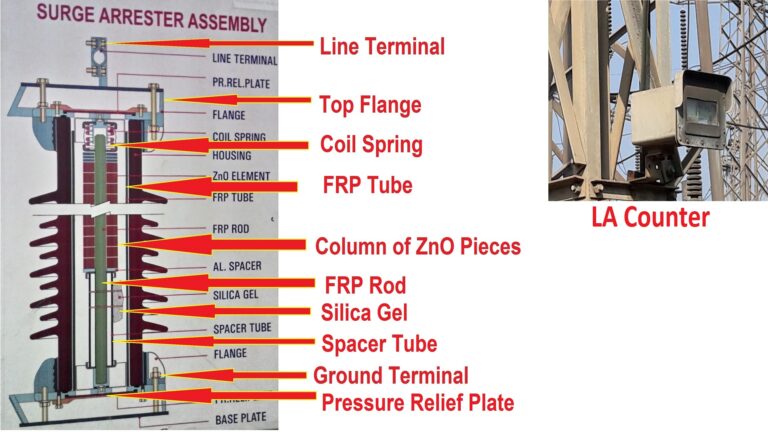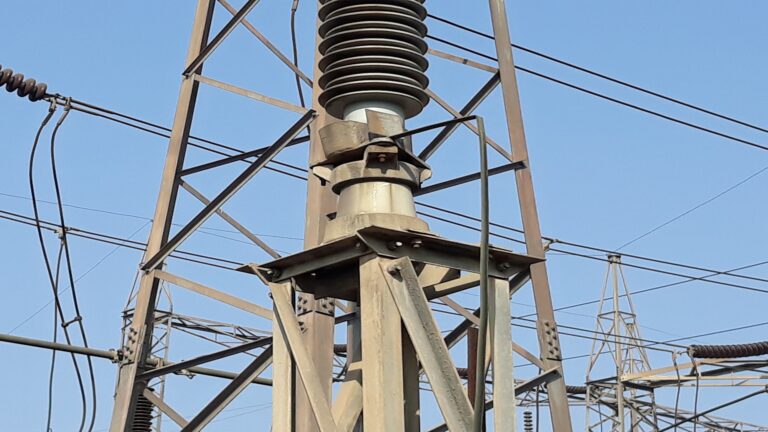LA - Lightning Arresters also called Surge Arrester/Diverter, in Electrical Substations
Let’s see, the working principle and function of LA. Also, the assembly i.e. the internal components of LA. And Finally LA Earthing.
First of all, let’s see LA components.
1. Gradient ring 2. Line terminal, connected to a phase live terminal 3. Porcelain housing 4. ZnO column (ZnO means a zinc oxide) 5. LA Ground Terminal 6. Body earthing point 7. LA counter

The function of LA: As the name suggests the function of LA is to divert abnormal high voltage to the ground caused due lightning phenomena or switching operations, without affecting the continuity of supply. Thus it saves electrical equipment from any possible damage due to high voltage surges.

Now, let’s see the working principle and assembly of internal parts Surge Arrester.
Surge Arresters are connected between phase and ground terminals. If we cut open any lightning arrester (refer the first picture) we can see the line terminal. Which is connected to the phase live terminal and this bottom terminal is connected to the ground. Main component of LA is a column of ZnO pieces, which plays important role in LA working. If we look at zinc oxide characteristics, which are non-linear. ZnO offers relatively high resistance at a low voltage level. And very low resistance at high voltage level.

Hence whenever a high voltage surge occurs, LA offers the least resistance path, and current flows through LA to the ground, avoiding any other path. Hence all other equipment such as transformers do not experience high voltage surges. As in the first picture, we can see the top flange. Coil spring to put pressure on and hold tight the ZnO column. FRP tube and FRP rod are used to improve the mechanical strength and insulation property of LA. FRP means fiber-reinforced plastic. Silica gel is used to keep internal parts of LA dry. A spacer tube is used to get desired height of LA. Bottom flange. Bottom pressure relief plate. This plate burst out in case of LA bursts and releases the pressure. And base plate. So this is the complete assembly of LA.
Now let’s see, the Function of the Gradient Ring. Why do we use gradient ring in LA?
The gradient ring is used only in high rating LA which is relatively taller. The reason is that every ZnO element stacked inside the arrester has its own capacitance. As shown in diagram C is ZnO’s own capacitance. That means capacitance C is formed inside one ZnO element. But this ZnO element forms capacitance with another ZnO element and also with the ground. As we can see in the diagram along with its own capacitance C, ZnO forms capacitance with other ZnO pieces and with ground shown as C1, C2, and so on. This type of capacitance with other ZnO elements and ground is called stray capacitance. This stray capacitance value is negligible as compared to ZnO’s own capacitance in the case of short-length LA. Hence voltage distribution is uniform across LA. In the case of long length, LA stray capacitance is significant as compared to ZnO’s own capacitance. Hence voltage distribution is not uniform and is very high at the top as compared to the bottom. Here we can see without a gradient ring, V1 is greater than V2, and so on. This may lead to mal-operation of the surge arrester. Hence gradient ring is used to get uniform voltage distribution across LA. Here, with gradient ring voltages V1, V2, and so on are equal. Hence uniform voltage distribution is achieved.



Now most important, earthing of the surge arrester. Usually, we earth body of all the electrical equipment. But in the case of surge arrester, two separate earthings are required. One body earthing and second ground terminal earthing. This ground terminal is the point through which the surge arrester passes current to the ground. Hence separate and solid earthing is required for this terminal. Else LA will not be able to pass surges to earth causing abnormalities in function. This may lead to damage to subsequent electrical equipment. Hence LA earthing is very important.
